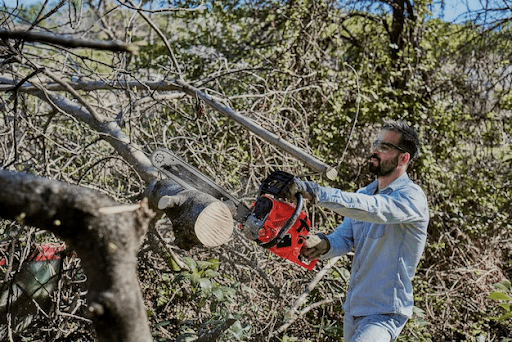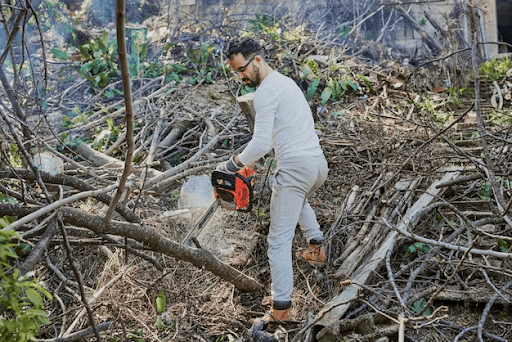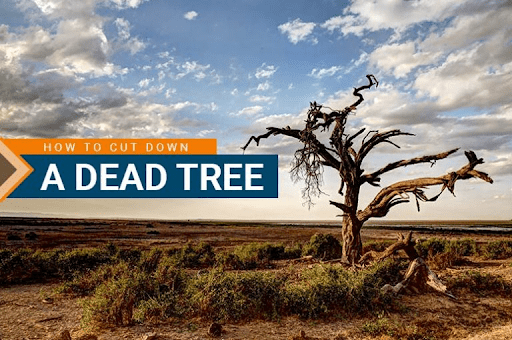Dead trees are hazardous to the people and the properties around them. This is because the wood in a dead tree no longer holds nutrients and moisture from the roots; they become brittle and susceptible to breakage. And when these branches break and fall, they bring significant problems, such as damage to cars, roofs, and utility lines.
In a worst-case scenario, dead branches could fall on people, causing severe to fatal injuries. This is why it’s best to have them removed urgently. We have gathered some of the top tips on cutting down a dead tree, which will help you know how to take care of the tree removal process better.
Handling felling a tree can be too complicated but, most importantly, dangerous. Without the proper tools and knowledge about performing correct tree removal work, you could end up causing more harm than good.
If you’re dealing with a large dead tree, it’s best to enlist the services of a professional tree specialist. But, if you think your small to medium-sized tree is something you can handle on your own, be sure to be prepared for the gruelling task ahead.
Read this guide on how to cut dead trees safely and successfully.
1. Diagnose Your Tree
Before you take down a tree, make a thorough inspection of your tree to be completely sure that it’s really dead. If you see brown and brittle branches, do the scratch test. Snap a few small branches and scratch off a section of their bark. Your tree is still alive if the exposed area is still green and moist. But the tree might be dead if it’s brown and dry.
Check a few small branches or twigs to ensure you arrive at a correct conclusion. Also, watch out for other signs of tree death, such as mushroom or fungal growth, peeling barks, thinning foliage, and a leaning trunk. And, if you’re not completely sure your tree is dead, get a professional arborist to inspect and provide a diagnosis. A tree may seem dead to you, but a tree specialist with years of training and experience may see a tree that can still be saved.
2. Plan Ahead
Identify the spot where you want your tree to fall. Do this by considering the height and lean of the tree. There should be enough space for it to completely fall without hitting power lines, structures, and passersby. Then, plan escape routes to quickly walk towards when your tree starts to fall. You will need two escape routes if your tree falls in a different direction than planned. Ensure they are clear of trip hazards such as sticks, stones, and other debris to avoid getting injured while running to safety. Keep people and pets safely away from the area before beginning to cut. Moreover, it is essential to conduct thorough research on tree felling techniques and learn how to safely and efficiently fell a tree using a chainsaw.
3. Perform Safety Checks
Prior to cutting a dead tree, watch out for any hazards and obstacles that may interfere with the task ahead. Remove objects that may be under the tree’s fall path. Pick up or sweep any tripping hazards that could get in the way while you work. Also, ensure your chainsaw is properly oiled and sharp, with its chain correctly tensioned.


4. Protect Yourself
You should always keep your safety in mind when dealing with felling trees and handling chainsaws. You should have essential safety gear such as a logger’s helmet, earmuffs, safety glasses, and Kevlar chaps. Also, wear sturdy shoes and clothes covering most of your skin. Cutting down a tree is serious work, and the dangers could be fatal. You should never forget to protect yourself as much as you can.
5. Cut Your Dead Tree
MAKE A NOTCH
At a comfortable working height, cut a face cut or directional notch on the tree at the fall side of the trunk. Make the top cut first by cutting downward at a steep angle of about one-fifth of the tree trunk’s diameter. Then, make the bottom cut from below, meeting your top cut until your notch looks like a mouth at an approximate 70-degree opening.
MAKE A BORE CUT
Start making the back cut at the same level or a bit higher than the bottom of the notch. If the tree leans backward, cutting higher will force the tree to drop toward the face notch and the aimed direction. Continue sawing until the back cut is within 10% of the tree’s diameter. Never cut through the face notch to create a hinge to help guide the tree to fall in the right direction.
USE WEDGES
Although you can cut a small tree without them, large trees will require wedges. They will help guide your tree to fall in the direction of the notch cut. Insert them two inches into the bore cut and hammer another wedge into the opposite side of the tree for better results.
CUT THROUGH THE BORE CUT
Position your chainsaw at the opposite end of the notch and cut the remaining wood through your tree. Continue cutting carefully until your tree begins falling toward the notch. Do not rush the cut to ensure you have plenty of time to move away from your tree when it starts to fall.
6. Move Away From The Fall Path
As soon as your tree starts to fall, shut off the chainsaw, set it down, and run toward your escape route. Keep an eye on the tree to ensure you are moving away instead of into its fall path. Keep moving away until you are sure you’re in the safe zone.


7. Clear The Area
When the dead tree finally hits the ground, retrieve your chainsaw. Start cutting limbs and start turning the trunk into logs. You can dispose of or use them later as firewood or mulch. Remove any remaining debris that may cause accidents. Don’t forget to clean and keep your chainsaw in a safe location after its use..
8. Dispose of the debris properly
Once done with cutting the tree effectively, it is important to dispose of the debris properly. You can do this by removing the fallen branches, limbs, or wood, ensuring that you keep the area safe and tidy. However, to dispose of the debris, you will need the assistance of professional tree services in Sydney. And when it comes to opting for professional tree services, tall timber tree services are your ultimate stop. Also, with the help of proper disposal, you can not only maintain the aesthetics of your property but also prevent potential hazards or damage caused by rotting wood or leftover debris.
Removing a dead tree is a good precaution to avoid property damage and injuries. Use this guide on cutting down a dead tree to ensure you do it safely and correctly. But, if you are not confident that you can handle this big task alone, seek help from the professional arborists at Tall Timbers Tree Services. Our training and experiences will help ensure that the job is done correctly without causing any harm to anything or anyone on your property. Hiring a professional can save you time and prevent you from making decisions you might later regret. Speak with our Tall Timbers Tree Services experts by calling us on 0414 627 627.
With our years of experience in the industry, we have developed a deep understanding of tree care and thus offer superior services in all aspects of this field. We also take great pride in preserving and maintaining the health and beauty of your trees. Moreover, our skilled professionals work with state-of-the-art equipment to tackle even the most challenging tree care tasks safely and efficiently. Our approach has made us one of the best tree-cutting services in Sydney.
When you choose us for complete tree removal, you are choosing a team dedicated to providing exceptional service and delivering outstanding results concerning tree care.

